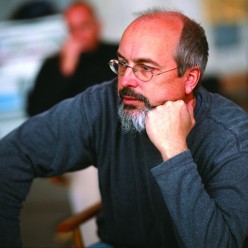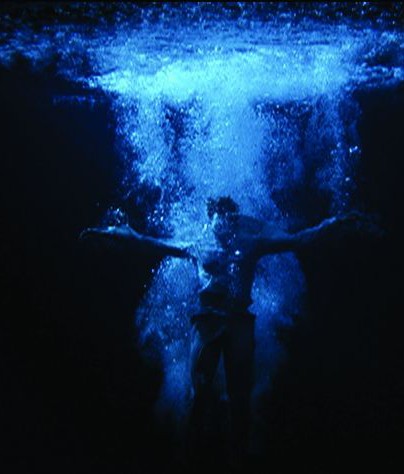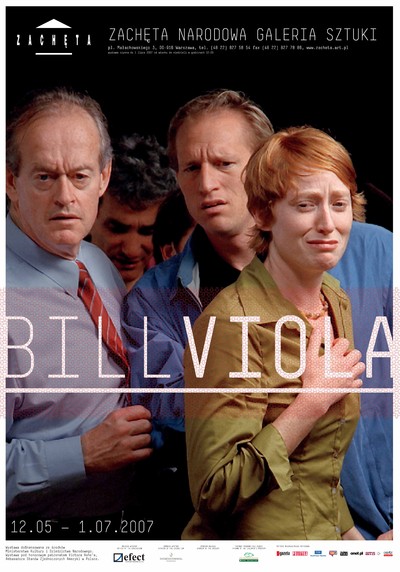Bill Viola
12.05 – 01.07.2007 Bill Viola
Zachęta National Gallery of Art
curator: Maria Brewinska
assistant curator: Joanna Sokolowska
Bill Viola Studio
executive director: Kira Perov
studio director: Bettina Jablonski
The Bill Viola exhibition in Zachęta is the first individual presentation of the work of this outstanding artist and pioneer in video art who has played a major role in the recognition of video as new form of artistic expression and in the development of this medium.
Over the course of the over 35 years of his work, Viola has created many groundbreaking films and video-installations that engage the viewer on many levels: intellectual, emotional and perceptual. Through the visualisation of images, contents and states which symbolise a human’s condition and place in the world, Viola’s work addresses the fundamental questions of human existence. The artist takes his inspiration from travel, poetry and philosophy, traditional art, Christian mysticism, Islamic Sufism and Zen Buddhism, and also deep personal experiences. In Viola’s works, individual content is linked with group and historical memory, psychic experiences with physical encounters, and direct perceptual experiences with those that are the product of the imagination. The artist records reality and confronts it with the images of the subconscious, in which knowledge is interweaved with memory and emotions. In this process, the camera comes to play the role of the ‘mind’s eye’: it enables the unveiling of different aspects of reality (internal and external), the anticipation of events or their recalling from memory, and also the creation of the world and the giving back to us of that which has been lost. Viola believes that the camera is not just an instrument of perception, but also a discursive instrument and that the images recorded on it confront us with the fundamental questions of life, change and momentary stability in the constant cycles of changes. The works of Viola research the properties of video, its temporal, visual and sound dimensions, in order to metaphorically show characteristics of perception and apprehension.
At the exhibition, we present 9 works, including The Crossing (1996), The Raft (2004) and Ascension (2000), works that make reference to the symbolism of the elements. Particular significance is attributed to water, the symbol that recurs most frequently in the artist’s works, and which conveys connotations of changes, birth and death, but also of the forces of nature, and spiritual cleansing. The work The Crossing is composed of two simultaneous projections, showing, on the one side a man consumed by fire, while on the other he is consumed by water. The video makes reference to the destructive action of the elements, while also indicating their cathartic power. In Ascension we see a figure falling into the deep water. This is a metaphor for the passage of the body into the sphere of infinity, a return to a primeval state of formlessness and unconsciousness. The work The Raft, on the other hand, relates to a catastrophic aspect of water - a flood. In it we observe how a group of people, who look as though they are waiting perhaps for a metro, are suddenly struck by a deluge of water and how they pick themselves up after such an attack by an element. Being plunged into water signifies the fall and the disruption of the consciousness produced by shock, after which takes place a rebirth, a spiritual regeneration as though after a symbolic christening. We also present a work which marks a turning-point in Viola’s work: The Greeting (1995), inspired by Jacopo Pontormo’s painting The Visitation (1528–1529). It is one of the artist’s first works to take up the question of the depiction of emotions in relation to the traditions of painting. Viola went on to develop this theme further in later years, in particular through his research into the portrayal of emotional states in Renaissance and Middle Ages painting at the Getty Research Institute in Los Angeles in 1998. At the same time, he has explored the possibilities of the visual and thematic translation of the layers of painting into the language of video. A result of these explorations is the cycle of works The Passions, which he began in 1999. At the exhibition in Zachęta, we present the following works from this cycle: Silent Mountain (2001), Surrender (2001), The Locked Garden (2000), The Quintet of the Astonished (2000) and Observance (2002). These works focus on the research into and presentation of emotional states, expressed through the language of the body and in facial expressions, modelled amongst others on religious painting from the late Middle Ages and Renaissance. In these works use is made of the formal conventions of painting and the plasma and LCD screens are arranged in traditional diptych or triptych forms. In them, short scenes, arranged and recorded by the artist and played by actors and which last just a few seconds, are slowed down so that the projection is extended in time, deforming the image and undermining the impression of the illusion and linear quality of narrative. The slowing of the image concentrates attention on the waves of powerful emotion that rise and fall in the characters. The effect of a pausing of time, the neutral background to the scenes in combination with the contemporary outfits of the actors, and the playing of scenes drawn from iconography are all factors in giving Viola’s works a universal character. Making use of the traditions of traditional art, he draws from them their spiritual vales, cultural archetypes and cosmological imagination and communicates them by translating them into contemporary images and experiences. Viola brings us closer to the essence of the medium, by bringing us closer to the complex realms of our existence, and since the medium is a creation in time, these works become a reflection of the impermanence of human existence.
Bill Viola’s works have been shown amongst others at: the 49th Biennale in Venice; in the Museum of Modern Art; Whitney Museum of American Art, Metropolitan Museum of Art (New York); Guggenheim Museum (New York, Berlin, Bilbao); San Francisco Museum of Modern Art; Museum of Contemporary Art (Los Angeles); Musée d'Art Moderne de la Ville de Paris; Moderna Museet (Stockholm); Stedelijk Museum (Amsterdam), National Gallery, Tate Modern (London); Mori Art Museum (Tokyo), Kunsthalle Düsseldorf, Tel Aviv Museum of Art.
The exhibition in Zachęta will be accompanied by a 160 page, richly illustrated catalogue, with texts by: Maria Brewińska, Benjamin Cope, Minoru Hatanaki and Jarosław Lubiak.

Born in 1951, and lives with his wife and collaborator Kira Perov in Long Beach, California. He graduated from the Experimental Studios at the College of Visual and Performing Arts, Syracuse University in 1973. In the mid 70’s he worked in Florence as the technical director of Art/Tapes/22, one of the first video art studios in Europe. He travelled widely to study and record traditional performing arts, plays, concerts and ceremonies, in, amongst others, the Solomon Islands, Java, Bali, and Japan. From 1973 to 1980, he worked together with the avant-garde composer David Tudor. In 1980, he and Kira lived in Japan where they studied new technology and Zen Buddhism from the master Daien Tanaka. In 1981, he became the first artist-in-residence at Sony Corporation’s Atsugi research laboratories, where he worked with the latest audio/visual technology. He also studied techniques of the medical depiction of the human body at the Long Beach Memorial Medical Center in 1983. In 1984, he began a long-term project devoted to the consciousness of animals. In 1994 he was invited by the Ensemble Modern in Frankfurt to create a work based on Edgard Varèse’s music piece Déserts that is projected during concerts. In 1995, at the 46th Venice Biennale, he presented a new cycle of five installations Buried Secrets, including The Greeting, one of the first of the artist’s works inspired by painting. In 1998, he spent a year at the Getty Research Institute in Los Angeles, where he studied the expression of emotion in the art of the Renaissance and Middle Ages. A year later he began work on a three year project The Passions involving the participation of actors. In 2002, he created his first project using high-definition digital video, the cycle Going Forth By Day, inspired by Tuscan frescoes from the late Middle Ages and Renaissance. Most recently, in collaboration with theatre director Peter Sellars and conductor Esa-Pekka Salonen, he worked on a new adaptation of Richard Wagner’s opera, Tristan und Isolde, that had its premiere in Walt Disney Concert Hall, 2004, and fully staged at the Opéra Bastille in Paris in 2005.
Bill Viola
12.05 – 01.07.2007
Zachęta National Gallery of Art
pl. Małachowskiego 3, 00-916 Warsaw
See on the map
The exhibition supported by the Ministry of Culture and National Heritage of the Republic of Poland.
Exhibition organized under the honorary patronage of His Excellency Victor Ashe, Ambassador of the United States in Poland.
Special thanks are extended to James Cohan of the James Cohan Gallery, New York.
exhibition patron: Efect Doradztwo finansowe
sponsor of the exhibition: Intercontinental Warszawa
sponsors of the gallery: Epson, Netia
sponsor of the opening ceremony: A. Blikle, Freixenet
patron of the children's program: Bank Zachodni WBK
media patronage: Gazeta Wyborcza, Polityka, Telewizja Polska, Tok FM, The Warsaw Voice, Onet.pl, ams, EMPIK

